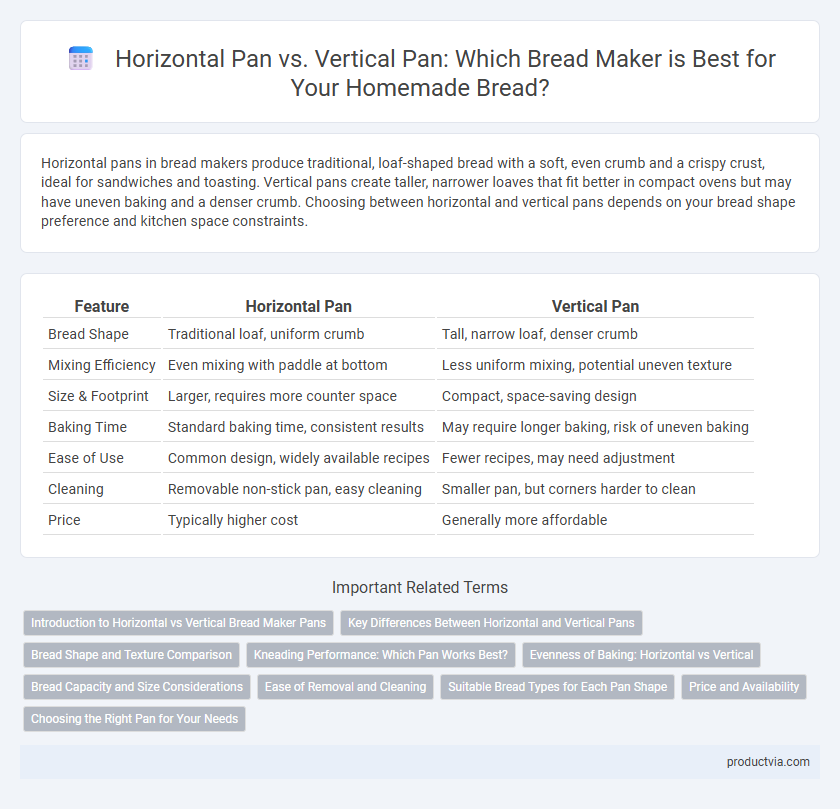Horizontal pans in bread makers produce traditional, loaf-shaped bread with a soft, even crumb and a crispy crust, ideal for sandwiches and toasting. Vertical pans create taller, narrower loaves that fit better in compact ovens but may have uneven baking and a denser crumb. Choosing between horizontal and vertical pans depends on your bread shape preference and kitchen space constraints.
Table of Comparison
| Feature | Horizontal Pan | Vertical Pan |
|---|---|---|
| Bread Shape | Traditional loaf, uniform crumb | Tall, narrow loaf, denser crumb |
| Mixing Efficiency | Even mixing with paddle at bottom | Less uniform mixing, potential uneven texture |
| Size & Footprint | Larger, requires more counter space | Compact, space-saving design |
| Baking Time | Standard baking time, consistent results | May require longer baking, risk of uneven baking |
| Ease of Use | Common design, widely available recipes | Fewer recipes, may need adjustment |
| Cleaning | Removable non-stick pan, easy cleaning | Smaller pan, but corners harder to clean |
| Price | Typically higher cost | Generally more affordable |
Introduction to Horizontal vs Vertical Bread Maker Pans
Horizontal bread maker pans provide a wider, rectangular shape that promotes even kneading and consistent crust formation, ideal for traditional loaf shapes. Vertical bread maker pans are taller and narrower, producing loaf shapes closer to bakery-style sandwich bread, but may result in denser textures due to restricted dough expansion. Choosing between horizontal and vertical pans impacts crumb structure and baking uniformity, influencing final bread quality.
Key Differences Between Horizontal and Vertical Pans
Horizontal bread maker pans produce loaves with a traditional shape, offering more even baking and a consistent crumb structure due to the wider surface area. Vertical pans, often shaped like tall cylinders, tend to yield taller, more compact loaves but may result in uneven baking with denser textures near the bottom. The choice between horizontal and vertical pans impacts the bread's shape, crust thickness, and internal texture, affecting the overall baking performance and final product quality.
Bread Shape and Texture Comparison
Horizontal pans in bread makers produce rectangular loaves with a uniform crumb structure, often preferred for traditional sandwich bread due to even heat distribution. Vertical pans yield taller, cylindrical loaves with a denser texture and a chewier crust, suitable for artisan or rustic-style bread. The pan orientation influences dough rising patterns, directly affecting the bread's shape and crumb consistency.
Kneading Performance: Which Pan Works Best?
Horizontal pans in bread makers typically offer superior kneading performance due to their wider surface area, allowing dough to spread and mix more uniformly. Vertical pans often result in denser kneading as the dough mixes in a confined space, which can limit gluten development and texture quality. For optimal kneading and consistent bread crumb structure, horizontal pan bread makers are generally preferred by bakers.
Evenness of Baking: Horizontal vs Vertical
Horizontal pans in bread makers promote more even baking by allowing heat to circulate uniformly around the dough, resulting in consistent crust and crumb texture. Vertical pans often lead to uneven baking, with the top of the loaf cooking faster than the center due to limited heat distribution. Choosing a bread maker with a horizontal pan ensures balanced baking and a more professional-quality loaf.
Bread Capacity and Size Considerations
Horizontal pans in bread makers typically offer larger bread capacity, often producing loaves up to 2 pounds or more, ideal for families or bulk baking. Vertical pans generally create taller, narrower loaves with smaller capacity, usually under 1.5 pounds, saving counter space but limiting loaf size. Choosing between horizontal and vertical pans depends on kitchen space availability and the desired amount of bread per baking cycle.
Ease of Removal and Cleaning
Horizontal pans in bread makers typically offer easier loaf removal due to their wider surface area and flat shape, minimizing the risk of crumbs or dough sticking to corners. Vertical pans can be more challenging to clean thoroughly, as their narrower design often traps dough residue in tight spaces. Choosing a horizontal pan improves cleaning efficiency and overall convenience after baking.
Suitable Bread Types for Each Pan Shape
Horizontal pans in bread makers are ideal for baking traditional loaves with a soft crust and uniform crumb, such as sandwich bread and French bread, due to their wide and shallow shape that allows even heat distribution and proper dough rising. Vertical pans suit denser, taller bread types like rye and multigrain loaves, where the dough rises upward to create a compact structure, often preferred for artisan or specialty breads. Choosing between horizontal and vertical pans directly affects the texture and shape of the bread, influencing the types of recipes that can be successfully prepared.
Price and Availability
Horizontal pan bread makers typically offer a wider range of models at varying price points, making them more accessible to budget-conscious consumers. Vertical pan bread makers, while often more compact, tend to be less common and can come at a higher price due to limited availability. Availability of replacement parts and accessories also tends to be better for horizontal pan models, supporting long-term use.
Choosing the Right Pan for Your Needs
Horizontal pans in bread makers produce loaves resembling traditional sandwich bread with an even crumb and a soft crust, ideal for slicing and sandwiches. Vertical pans create tall, cylindrical loaves with a denser texture, suitable for artisan-style bread and recipes requiring a chewy crust. Selecting the right pan depends on preferred bread shape, texture, and recipe versatility, ensuring the best results for your baking needs.
Horizontal pan vs Vertical pan for bread makers Infographic

 productvia.com
productvia.com